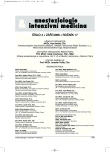Difficult Airways – prediction and management
Authors:
T. Strang 1; P. Michálek 2
Authors‘ workplace:
Department of Anaesthesia, South Manchester University Hospital, Manchester, United Kingdom
1; Department of Anaesthetics, Antrim Area Hospital, Antrim, United Kingdom/Northern Ireland
2
Published in:
Anest. intenziv. Med., 17, 2006, č. 4, s. 195-202
Category:
Anaesthesiology - Comprehensive Report
Overview
Difficult intubation is uncommon and fortunately the “can’t ventilate can’t intubate“ scenario is extremely rare (1 : 5000). However both remain important causes of anaesthesia-related mortality and morbidity. The ability to predict problems results in improved outcome but sadly our methods remain to date disappointing in accuracy. A number of algorithms have now been developed to guide the physician meeting a difficult airway in predicted or unexpected circumstances. There are many basic and advanced techniques of airway management that anaesthetists should be competent to perform after training. Fibreoptic intubation remains probably the “gold standard” for management of the anticipated difficult airway.
Key words:
intubation endotracheal – difficult airway management – laryngeal mask – fibreoptic intubation
Labels
Anaesthesiology, Resuscitation and Inten Intensive Care MedicineArticle was published in
Anaesthesiology and Intensive Care Medicine

2006 Issue 4
Most read in this issue
- Difficult Airways – prediction and management
- Death of a novice scuba diver after sudden emergence from a 5-meter depth – case report
- Perioperative spinal cord monitoring during spinal surgery
- New developments in haemodynamic monitoring: Part I
